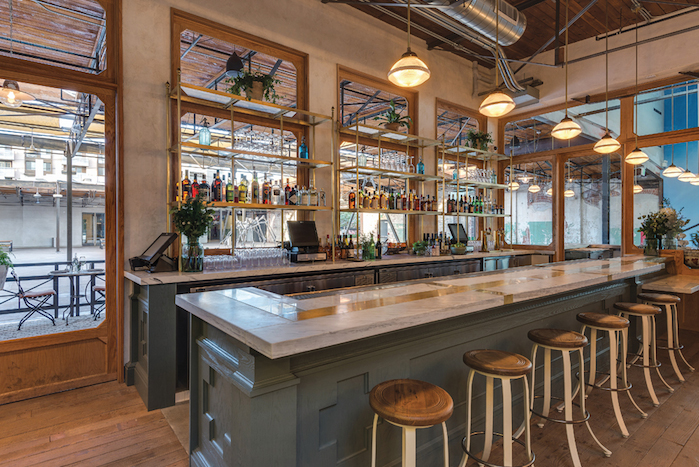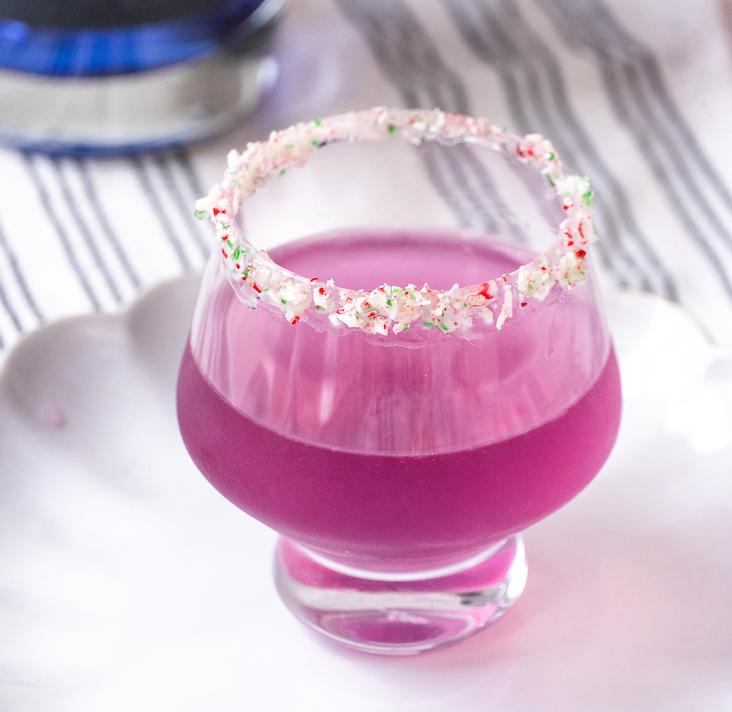A lot goes into the making of a great bar, from the design and decor to beverage selection and service to music choices, lighting and overall vibe. But if your bar is messy, unsafe and disorganized, it will be hard to achieve or sustain greatness and to keep guests—and bar staff—happy. Here are a few tips from some experts for improving your bar’s setup and efficiency.
1) Do as much pre-shift bar prep as possible
“We have a pre-week prep shift on Tuesday mornings when we are not open,” says Niki Kotantoulas, beverage director for the 120-seat local and seasonally focused restaurant Manuela in Los Angeles (pictured atop). “This involves the making of any infusions, syrups and some of the juices we will need for the rest of the week.” The restaurant, which sells about 1,000 cocktails a week, sources its citrus from nearby Shaner Farms, along with fresh herbs and other ingredients for garnishes.
At the 172-seat Bourbon Steak in Washington, D.C., which sells around 1,075 cocktails a week, staff starts from scratch every day. “There’s time-intensive prep work in juicing, slicing, making syrups, house tinctures and hand-carving ice,” explains head bartender Torrence Swain. Hand-squeezing juice alone can take two hours, he adds.
Bourbon Steak also restocks spirits and mixers before each shift, and fills the ice bins. Swain is mindful of overstocking, as it cuts down on space. So if Bourbon Steak’s records show it sells about 15 bottles of a certain brand of beer each evening, for example, Swain will stock no more than 20 and replenish as needed.

Bourbon Steak in Washington, D.C., recently installed a third well in its bar to keep up the pace and streamline the process.
2) Look for space-saving solutions
To make the most of the limited space behind the bar, store only the items used to make drinks there, and try to eliminate single-use products, advise Tony Garcia, director of beverage operations, and Kurt Moody, beverage operations and training manager, for Houston-based food and beverage marketing agency Patrick Henry Creative Promotions.
They also stress thinking outside the box when it comes to organizing tools. For instance, a Lazy Susan can work in the mix cooler, and 3M hooks are great for hanging bar tools.
“Shelving and glass racks are your best friends,” says Kotantoulas. “Real estate is so valuable behind the bar, and glass racks help us utilize our shelves as much as we can.”
Kevin Bratt, concept beverage director for Joe’s Seafood, Prime Steak & Stone Crab, which operates locations Chicago, Las Vegas and Washington, D.C., agrees. Shelving units installed in open areas will make the best use of space, he notes.
3) Create separate and identical stations
Each bartender at Joe’s Seafood, Prime Steak & Stone Crab is assigned to a station at the beginning of each shift. He or she is responsible for serving a certain number of guests at the bar as well as in the dining room. The stations are stocked with everything bartenders need, says Bratt.
Swain keeps a maximum of three bartenders working at the same time, along with two bar backs. “Having a designated station for each person keeps everything running smoothly without people tripping over each other,” he says.
At PCH, an 82-seat craft cocktail bar in San Francisco that sells about 1,800 a week, dozens of bottles and jars of tinctures, bitters and infusions line the back bar. That makes daily set-up pretty intense, says general manager/partner Kevin Diedrich, so organization is key.
“Each one of our stations is exactly identical to the next. That way, each bartender can hop into any of the stations and continue to work no matter what side of the bar they are on,” Diedrich explains. Juices, bitters and dashers are always on the right side of the well, while syrups ard on the left, all organized by cocktails and volume. “All this is mapped out a sort of ‘map’ that is laminated and stored behind the bar [so] whoever is setting up the bar has the same setup every single day.”
Symmetry is indeed key, says Shel Bourdon, director of bars for Two Roads Hospitality, a lifestyle hotel management company. If a bar has more than one well, each should be set identically, with everything from cheater bottles to garnishes. “It’s all about muscle memory,” she notes.
4) Properly label and store perishable and other ingredients
Bar staff at Manuela works with the kitchen to keep bar produce separate and organized. Herbs and garnishes are stored behind the bar. “Labeling is very important,” says Kotantoulas. “Every ingredient, fresh juice and infusion that we make that has a shelf life is labeled with a date.”
At the 460-seat Joe’s Seafood, Prime Steak & Stone Crab location in Chicago, which does 2,800 cocktails per week, citrus and juice mixes are made fresh in-house every day. They’re stored in a low-humidity and temperature-controlled environment in clearly marked bottles within arm’s reach, and discarded at the end of every evening.
Garnishes such as fresh mint, lime wedges and wheels and other fruit may be fine the next day, but their flavors change slightly as they dry, says Swain at Bourbon Steak. He offers leftovers like fresh orange juice to his staff to take home.

At San Francisco cocktail bar PCH, where dozens of bottles and jars of tinctures, bitters and infusions line the back bar, each bartender station is identical to the next.
5) Organize products to serve best sellers
The beverage team at Patrick Henry Creative Promotions recommends carefully reviewing the numbers. Use historical sales data—including previous year, month, week and day—to anticipate future sales’ expectations and adjust production and placement of ingredients accordingly. Review your product mix report and ensure you can make all of your top-selling cocktails within two steps from the ice bin.
Bratt concurs: “If vodka-based cocktails rank among the highest-volume sales, that spirit should be zoned in the rail closest to the station of service, limiting the number of steps needed to retrieve the items frequently used.”
At PCH, Diedrich says everything on the bartop and in the wells is placed with one arm’s reach and half a step away. This equates to fewer and more precise movements, which is faster for bartenders and reduces fatigue.
6) Don’t skimp on slip mats
The function of proper mats goes beyond bartender comfort, Bratt points out. “Slip-resistant bar mats are a necessity when it comes to avoiding slips [and falls],” he says. Mats can also lessen the frequency of dropped bottles or glassware actually breaking.
To keep staffers safe, make sure your mat is kept in good condition and replace regularly as needed, says Swain. Bourbon Steak replaces the bar mat at least every six months, even before it starts to wear down.
7) Keep glasses moving
Glassware can make or break the speed of service, says Kotantoulas; it must remain a priority throughout a shift. Replenishing and polishing the glasses will most likely be a barback’s main job during the bulk of his or her shift, but don’t let the bar become overrun with dirty glassware and spills.
You should also maintain a separate container for broken glass and any other sharp items, recommend Garcia and Moody. And avoid stacking glassware to prevent or minimize broken glasses.

The Bee’s Knees, a gin-focused cocktail den in Phoenix’s Camby Hotel, revamped its bar setup after a year to improve its efficiency.
8) Adjust the bar setup frequently
Garcia and Moody point out that as new programs roll out and as new drinks become top sellers, your setup has to evolve with it. The initial design of many lounges often does not anticipate the current volume.
At Bourbon Steak, for instance, constant consolidation and reconfiguration is necessary, Swain says. To that end, the owners recently installed a third well to keep up the pace and streamline the process.
Two Roads’ Camby Hotel in Phoenix opened a 43-seat gin-focused cocktail bar called the Bee’s Knees in 2015. The bar underwent a facelift after a year to improve its efficiency, Bourdon says.
For example, the glass washer was relocated to the underused side service station, making it possible to install a second ice well. The underbar’s new symmetry has allowed for a double speed rail—twice capacity for liquor bottles.
“Without changing any of the infrastructure, plumbing or lighting, we now have the capacity to serve twice as many cocktails to our guests,” Bourdon says.
Kelly Magyarics, DWS, is a wine, spirits and lifestyle writer, and wine educator, in the Washington, D.C. area.









